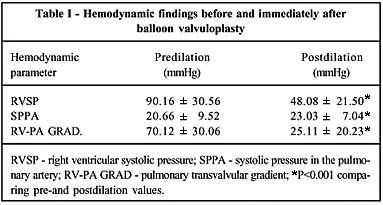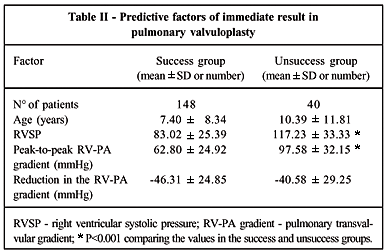OBJECTIVE: To assess the long-term results of percutaneous balloon valvuloplasty at a single institution. METHODS: This study comprised 189 patients with pulmonary valve stenosis undergoing percutaneous balloon valvuloplasty from 1984 to 1996, whose mean age was 7.97±9.25 years. The procedure was classified as successful when the RV-PA gradient was reduced to levels < 36 mmHg; restenosis was indicated by RV-PA gradients > 36 mmHg after an effective procedure. RESULTS: After the procedure, the peak-to-peak transvalvular gradient decreased from 70.12±30.06 to 25.11 ±20.23 mmHg (P<0.001). Immediate success was obtained in 148 (78.72%) patients. A later reduction in the gradient to values < 36 mmHg was obtained in 24 other patients previously categorized as unsuccessful. Therefore, percutaneous balloon valvuloplasty was considered effective in 172 (91.01%) patients. Effectiveness increased to 93.53% (159/170) in the cases of typical morphology. Follow-up ranged from 4.39±3 years to 13.01 years. Restenosis was observed in 24 (13.95%) patients. Pulmonary regurgitation was detected in 95.1% of the patients, being more intense than mild in 29.5% of the patients. The probability of maintaining an appropriate result, at any time point, with no restenosis was 92.29% in 2 years, 87.38% in 5 years, 82.46% in 8 years, and 64.48% in 10 years. CONCLUSION: Percutaneous balloon valvuloplasty was effective and safe for the treatment of pulmonary valve stenosis with excellent short- and long-term results.
valvuloplasty; pulmonary valve stenosis; results; echocardiography





